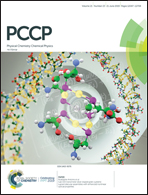Adiabatic deprotonation as an important competing pathway to ESIPT in photoacidic 2-phenylphenols†
Abstract
ESIPT (Excited State Intramolecular Proton Transfer) to C atom in 2-phenylphenol is known to be an intrinsically inefficient process. However, to the best of our knowledge, a structure-ESIPT efficiency relationship has not been elucidated yet. Here, we show that there exists a competitive interplay between photoacidity and ESIPT efficiency for the 2-phenylphenol system. The attachment of electron withdrawing groups to the phenol moiety promotes adiabatic deprotonation in the excited state and diminishes the charge transfer character of the excitations, and both these factors contribute in decreasing the ESIPT reaction yield. On the other hand, unfavorable conformational distribution in the ground state also appears as another important aspect responsible for the low ESIPT extent of 2-phenylphenol. A new derivative bearing electron donating, bulky substituents at ortho and para positions of the phenol ring shows an outstanding ESIPT performance, which demonstrates that the efficiency of the process can be significantly enhanced by modifying the substitution pattern. We anticipate that our results will help to guide the molecular designing of new compounds with high ESIPT efficiency.



 Please wait while we load your content...
Please wait while we load your content...